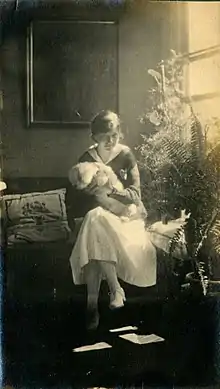Mary Welleck Garretson
Mary Welleck Garretson (December 16, 1896 - May 8, 1971) was an American geologist. Garretson had a passion for teaching earlier in her career, obtaining her first job at the Young Men's Christian Association (YMCA). From 1921 to 1923, she instructed an introductory geology course, which happened to be the first geology course conducted through this institution. Garretson was subsequently employed as a consultant within the fields of paleontology and stratigraphy.

Personal life
Garretson was born on December 16, 1896 to father Ernest Welleck, a scientific editor and journalist, and mother Mary Noble. Garretson was born in Cincinnati, Ohio where she resided for the majority of her childhood. Her maternal grandfather was Thomas Satterwhite Noble, a famous nineteenth century American artist. Whilst studying at Columbia University, Mary met her future husband, William Melvin Garretson and got married on September 27, 1922. She had two children, Mary Louise Garretson, and William Welleck Garretson. On May 8, 1971 in White Plains, New York, Garretson passed away after a battle with a serious life-long illness.[1]
Education
Garretson attended the Girls Latin School located in Boston, Massachusetts between the years of 1909-1914. She then attended Barnard College in Manhattan, New York, where she earned an A.B. (Bachelor of Arts) in 1918. While attending Barnard College, she engaged in a diverse range of studies, however she was mostly oriented towards the sciences. Garretson studied under Professor Amadeus W. Grabau, C. P. Berkey and F. K. Morris. Garretson later assisted Professor Amadeus W. Grabau in his research and publication.[1]
Following her graduation from Barnard College, she attended Columbia University in New York City, where she continued her studies in geology. While working towards her M.A. (Master of Arts) degree, Garretson specialized in invertebrate zoology, stratigraphy and sedimentation. Furthermore, while Garretson was completing her studies towards her M.A. at Columbia University, she worked as a graduate assistant.[1]
Work in geology and science
During her time as a graduate student at Columbia University, Garretson was employed as a teacher at the Young Men's Christian Association (YMCA), in which she taught an Introduction to Geology course from 1921 to 1923. It was at this time that she became an assistant at the Brooklyn Children's Museum, where she made multiple contributions throughout the 1920s. Still employed as a teacher, Garretson branched into the field of Geological consultations during World War Two. Post-war, she was hired by both airline and industrial companies from 1949 to 1951, where she studied and wrote about the geological characteristics of various areas for their benefit. One of these many articles was published in the New York Times, featuring her survey results about the geological characteristics of New York City.[1]Once her work as a geological consultant was completed, she returned to various teaching jobs, eventually becoming the President of the Haitian-American Resource Company from 1956 until the time of her death, in 1971. Garretson made tremendous contributions to the Haitian government via her consultation efforts and her advisement on mineral economics. She made significant developments in the geological studies and developments in Haiti.[1]
Garretson became an active member of various groups including The Geological Society of America, American Institute of Mining, Metallurgical and Petroleum Engineers, the International society of Economic Geologists, the American Geophysical Union, the Geological Society of China and the New York Historical Society. She was on the board of Directors of the Westchester County Conservation Association from 1933 to 1950, ultimately acknowledged as one of the founders.[1]
Research contributions with Amadeus Grabau
Professor Amadeus W. Grabau is regarded as the father of modern sedimentology and Garretson acted as the Professor's primary research assistant in many of his projects, including the theory of horizontal displacement, otherwise known as continental drift.[2] This refers to the horizontal movement of continents over an extended period of time.[3] She and Professor Grabau met during her studies at Columbia University. She had worked alongside him to create his book "North American Index Fossils". They were both supporters of Pangaea, which proposes that the earth was previously a supercontinent prior to continental drift.[3] Professor Grabau and Garretson made significant contributions to what is currently understood about sedimentation. While Professor Grabau continued his studies on continental stratigraphy and index fossils in China in the 1930’s, Garretson was his primary research assistant back in the United States of America. During Professor Grabau's extended stay in China, he wrote various research papers in which Garretson had assisted in writing and researching. She was a close correspondent and assistant to him until his death.[1]
References
- Behre, Charles H. "Memorial to Mary Welleck Garretson" (PDF).
- Friedman, Gerald M. (2007-03-01). "In memory of Professor Amadeus William Grabau (1870–1946) on the semicentennial of his death". Carbonates and Evaporites. 22 (1): 86–91. ISSN 1878-5212.
- "Continental Drift". education.nationalgeographic.org. Retrieved 2023-10-11.